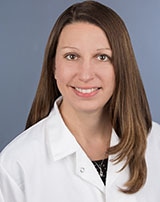May 17 2019
At UC Davis and UC San Francisco, researchers have discovered a new method through which a computer can be taught to accurately identify a hallmark of Alzheimer’s disease in human brain tissue, thus providing a proof of concept for a machine-learning strategy to differentiate the disease’s vital markers.
 Brittany Dugger, PhD (Image credit: UC Davis Health)
Brittany Dugger, PhD (Image credit: UC Davis Health)
Amyloid plaques are basically clumps of protein fragments that are found in the brains of individuals suffering from Alzheimer’s disease that damage nerve cell connections. Similar to the way Facebook identifies faces on the basis of captured images, the new machine learning tool created by a research team at the University of California has the ability to “see” whether a brain tissue sample has one type of amyloid plaque or another, and do it quite rapidly.
The results of the study, reported in Nature Communications on May 15th, 2019, suggest that machine learning can increase the analysis and expertise of a proficient neuropathologist. The new tool enables them to examine more data for a countless number of times and ask innovative questions that otherwise would not be feasible with the restricted data processing abilities of even the most extremely trained human experts.
We still need the pathologist. This is a tool, like a keyboard is for writing. As keyboards have aided in writing workflows, digital pathology paired with machine learning can aid with neuropathology workflows.
Brittany N. Dugger, PhD, Study Lead Author, and Assistant Professor, Department of Pathology and Laboratory Medicine, UC Davis
In this analysis, Dugger teamed up with Michael J. Keiser, PhD, an assistant professor in UCSF's Institute for Neurodegenerative Diseases and Department of Pharmaceutical Chemistry, to establish whether a computer could be taught to automate the arduous process of recognizing and examining very small amyloid plaques of different types in huge slices of autopsied brain tissue of humans. For this task, Keiser and his group created a computer program called “convolutional neural network” (CNN) to identify patterns on the basis of a countless number of human-labeled instances.
To produce sufficient training examples to teach the CNN algorithm the way Dugger examines the human brain tissue, the UCSF group worked with her to develop a technique that enabled her to quickly label or annotate tens of thousands of images from a pool of half a million close-up pictures of tissue from 43 diseased and healthy samples of brain.
Similar to a computer dating service that enables users to swipe right or left to label someone’s picture as “hot” or “not,” the team created a web platform that enabled Dugger to glance one-at-a-time at extremely closed-up areas of possible plaques and rapidly label or annotate what she viewed there. This unique digital pathology tool, called “blob or not” by the research team, enabled Dugger to label over 70,000 plaque candidates, or “blobs,” at a speed of approximately 2,000 images per hour.
This database of a countless number of labeled example images was utilized by the UCSF researchers to train their CNN machine-learning algorithm to recognize different kinds of brain changes observed in Alzheimer’s disease. That involves discerning between what is known as diffuse and cored plaques and detecting abnormalities in blood vessels. The scientists demonstrated that their machine-learning algorithm has the potential to process an entire whole-brain slice slide with a precision of 98.7%, with speed only restricted by the number of computer processors utilized by them. In the present study, the scientists employed a single graphics card like those utilized by home gamers.
Subsequently, the researchers carried out stringent tests on the identification skills of the computer to ensure that its analysis was biologically valid.
It’s notoriously hard to know what a machine-learning algorithm is actually doing under the hood, but we can open the black box and ask it to show us why it made its predictions.
Michael J. Keiser, PhD, and Assistant Professor, Institute for Neurodegenerative Diseases and Department of Pharmaceutical Chemistry, UCSF
Keiser went on to highlight that the machine learning algorithm is no better at recognizing amyloid plaques than Dugger—the neuropathologist who taught the computer to identify the plaques in the first place.
“But it's tireless and scalable,” Keiser stated. “It’s a co-pilot, a force multiplier that extends the scope of what we can accomplish and lets us ask questions we never would have attempted manually. For example, we can look for rare plaques in unexpected places that could give us important clues about the course of the disease.
In order to encourage the use of the machine learning tool, the team has made this tool and the study data publicly available online. Already, this has created interactions with other investigators who have assessed the algorithms and the data in their own laboratories. In the coming days, the team believes that algorithms like these will turn out to be a normal part of neuropathology studies, trained to aid researchers to examine huge quantities of data, diligently searching for patterns that can possibly provide a new understanding about the causes and potential treatments for Alzheimer’s disease.
If we can better characterize what we are seeing, this could provide further insights into the diversity of dementia/ It opens the door to precision medicine for dementia. These projects are phenomenal examples of cross-disciplinary translational science; neuropathologists, a statistician, a clinician, and engineers coming together, forming a dialogue and working together to solve a problem.
Brittany N. Dugger, PhD, Study Lead Author, Assistant Professor, Department of Pathology and Laboratory Medicine, UC Davis
Other study authors included Lee-Way Jin, Charles DeCarli, and Laurel Beckett from UC Davis; Kangway V. Chuang and Ziqi Tang from UCSF; and Tsinghua University in Beijing, China.
An NIH P30 AG010129, Paul G. Allen Family Foundation Distinguished Investigator Award, and the China Scholarship Council funded the study.